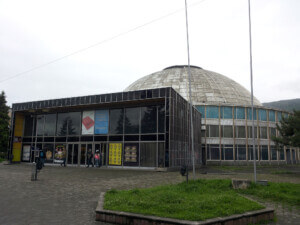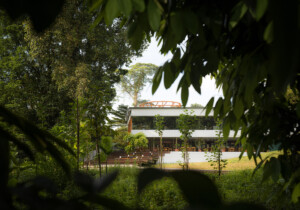Modernity and Durability: Perspectives for the Culture of Design
Vittorio Magnago Lampugnani
DOM Publishers, 2018
The ghost of modernity—the quest to define what it means to be modern, and what its fundamental principles are—has haunted Western culture for a long time. In his 1991 book We Have Never Been Modern the French philosopher Bruno Latour revised one of modernity’s main axioms—the separation between nature and society, humans and things—by claiming that the world we live in today is characterized by the constant hybridization of politics, science, technology, and nature.
Similar to Latour, the idea of modernity as a frustrated project is also present in Vittorio Magnago Lampugnani’s speculations on architecture and design, now collected for the first time in English in the book Modernity and Durability. Perspectives for the Culture of Design. Magnago Lampugnani, architect and professor of history of urban design at ETH Zurich for more than 20 years, is also a prolific writer and polemicist: his book, a series of micro-essays originally published between 1990 and 1994 in the Italian magazine Domus, is in fact a manifesto on the current status of design, where the author’s peculiar worldview is presented with extreme clarity and effectiveness. Magnago Lampugnani’s perspective—the one of a European intellectual, an enlighted sophisticated thinker who looks at design in terms of humanist values—is to some extent inscribed in a broader tradition that puts the Italian architect in good company. From Manfredo Tafuri’s idea of disincanto (disenchantment) to Pier Vittorio Aureli’s claim for autonomy, all these authors share a similar conviction: that architecture is a form of resistance. Resistance from consumerism, resistance from ephemerality, resistance from spectacle. In other words, resistance from capitalism.
Whereas Latour dissected modernity in relation to the role played by science, at the beginning of his speculations Magnago Lampugnani formulates a fundamental separation between what is Modern and modernism. What the Italian architect calls Modern is a broad condition: an era that begins at the turn of the 20th century and ends after World War II, whose brightest manifestation is the work of the Bauhaus under Walter Gropius’s direction. Modernism, on the contrary, is a style, a degeneration of the principles that animated this paradigm shift at the beginning of the century, and a banalization of the Modern message into a simplistic formal language.
Lampugnani’s assertions derive from a European-Eurocentric perspective; although he never makes it explicit, Lampugnani considers modernity mainly to be a European phenomenon, whose raison d’être is deeply rooted in a European cultural and social context. The only reference to American architecture, for example, is to a German architect based in the United States: Mies van der Rohe, and his Seagram Building in New York City. This doesn’t mean that the United States didn’t produce any Modern architecture, but that, once imported in the American territory, its original message was detached from its ideological impetus and was very soon transformed into a style.
After having established the dichotomy between Modern and modernism, Magnago Lampugnani deploys his main argument: in order to provide precise design solutions to contemporary issues, we have to reformulate the message of the Modern by preserving its original social and humanist aspirations while revising critically its means and its technical and economic content. Its ultimate goal, in Magnago Lampugnani’s idea, is to create a better world. How? Through a holistic approach. Against the current specialization of design into different professional categories, the author argues for a return to the figure of the architect as a “bricklayer who had learnt Latin”—to quote Adolf Loos—who can design good cities, good buildings, good interiors, and good furniture.
At the same time, Magnago Lampugnani suggests looking at design as a craft: “a patient, conscientious, accurate and competent work, whose result will always be useful, right, and fine.” To consider design as craft means to disconnect architecture, urban planning, and furniture from passing fashions. This way, design can reimagine conventions, or the system of rules sedimented in history aimed at guaranteeing functionality and economy of means. If design can exist as a system of rules, Magnago Lampugnani identifies some principles that can help recuperate the original message of the Modern and serve as an operative basis for the future. The first and main principle is durability, in a physical and cultural sense. To be durable, design must refer to tradition: by dealing with tradition, it’s possible to design cities and architectures that can transcend the oscillations of taste. At the same time, only permanence transforms design into a cultural entity—the expression of certain values in relation to a certain context.
The imaginary lexicon depicted by Magnago Lampugnani includes several other concepts: simplicity, which doesn’t translate in abstraction, but it means clarity and closeness to people’s needs; rigor, which is crucial to identifying the design’s requirements; essence, because every good design must be founded on a very few strong ideas—see Marcel Breuer’s S32 chair, or Villa Malaparte by Adalberto Libera; slowness, as an answer to the decline in the quality of our cities and buildings—here the author refers to the construction of St. Peter’s Basilica, in Rome, which took more than 120 years.
What emerges from this cosmology of terms is an ascetic dimension, a sort of passive resistance against hedonism and consumerism. And whereas the book seems to be in some points a sort of nostalgic celebration of the past, it’s in its last pages that Magnago Lampugnani delineates a project for the future. In reiterating the separation between the Modern as condition and modernism as style, the architect refers to the three Vitruvian principles—firmitas, utilitas, venustas—as main categories of the Modern but integrates them with two new ones: democracy and ecology.
Democratic and ecological commitment become urgent challenges for a Modern culture, as an attempt to create a new humanity: a “humanity that believes in the ideal of social justice as the prerequisite for peace and prosperity, and is ready to share the riches of the world equally among its citizens.”











